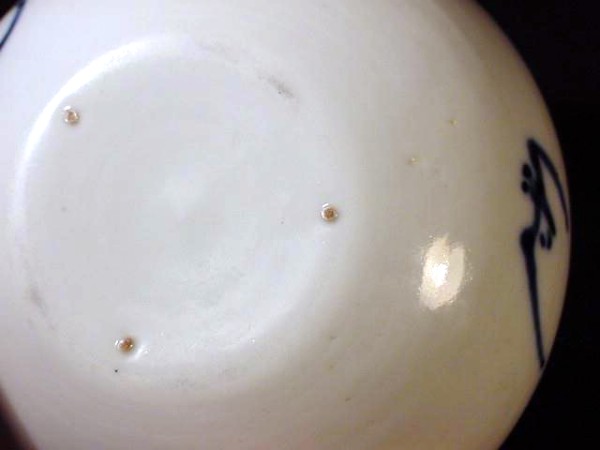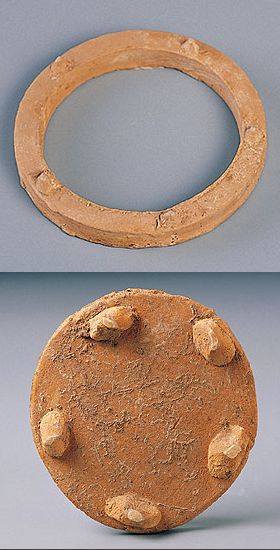
Rather unusual late Qing dynasty firing support marks on a seal paste "scholars object" box.

Different firing supports leave different looking marks on the base of the fired objects. An obvious thing to look out for on fakes are marks left by modern perfectly symmetrical metal supports.
Spur marks are the bits of clay or depressions left where the piece sat on kiln supports in the sagger when fired. Also 'kiln support marks'. The firing supports were used to support glazed wares in the kiln to prevent them from warping, sagging or sticking to whatever they would have sat on otherwise in the kiln during firing. These marks are found on the base surfaces, at or within the foot rims of dishes bowls, large jars etc.
As a mean of authentication it is worth noticing that antique kiln supports were as far as I know always made of clay and should therefore on close inspection leave a visible trace of clay in the "spur mark" like a broken off tooth, while modern supports used while copying antique glazes are often made of aluminum, and are therefore regular in their spacing and only leave a clean and empty impression in the glaze. To know the different kinds of fire supports that were used at different kilns at different times is very important for authentication and dating.
On Japanese porcelain, virtually every larger piece of export porcelain from the mid 18th century to the mid 19th century will be found to have one or several spur marks. Around the 1850's the number of spurs were reduced to mostly only one after which the practice was gradually phased out. The need arose from the Japanese working with a different clay more prune to warping than the Chinese, while trying to satisfy the export demand for thinner and more refined wares.
In China fire supports are common up until early Ming. On Chinese white-bodied stoneware or 'porcelain', fire supports are virtually non-existing after the Yuan dynasty except on wares deliberately copying older wares, and on rare monochromes whose glaze was runny. From the Yongzheng period Chinese porcelain copying Japanese porcelain (Deshima plates) are found also with spur marks. During the Qianlong period this feature was a deliberate occurrence even if the item wasn't actually fired on supports to simulate the archaic look, i.e. Song copies or those wares inspired by them.
During the first decades of the 20th century a larger proportion of the porcelain than before came to be of inventive and irregular shapes that again seems to have made firing supports - apparently small pebbles - quite commonplace.
Regarding older wares it is worth noticing that all 'spur marks' are fire supports, while all 'fire support marks' are not spur marks. During the Song and early Yuan dynasty in the Jingdezhen area the normal firing support used on upright standing white wares (Qingbai) was a small wad of clay that left a red burnt patch under the bases. At some occasions a circular wad was used and at other places a number of small wads, put around the edge of the base was used. This is a very large topic by itself but I will leave it at this.
For more information on Sung dynasty firing pads, see: Saggar
A